
When properly installed, the right yard hydrant can be used for all of the above any time of year, even in sub-zero winter temps. However, finding and selecting the best yard hydrant is easier said than done. That’s where we come in. We put dozens of models to the test to find the best of the best.
| Product | Flow Rate | |||||
|---|---|---|---|---|---|---|
| Woodford Y34 (Editor’s Choice) | Check Price | |||||
| Simmons Manufacturing | Check Price | |||||
| Everbilt | Check Price |
Table of Contents
1. Woodford Yard Hydrant Y34-4 – Best Frost Free Hydrant

Design and Materials
The Y34-4 is a USA-made product with a cast iron head and handle, and all of its other components are made of durable metal. The 3/8-inch steel operating rod and brass valve body ensure that there is no risk of flimsy plastic parts that may need frequent replacement. Its construction guarantees longevity and resilience.
Moreover, this hydrant incorporates several exceptional design details that are often overlooked by other manufacturers. The long-life graphite packing and the variable flow plunger are just two examples of its outstanding features that allow users to adjust the flow rate based on the specific application’s requirements.
Freeze-Proof Capability
One of the most noteworthy features of the Y34-4 is its freeze-proof design. The hydrant’s shut-off valve, when installed below the frost line, allows water in the pipe to drain out of the valve and prevent freezing. This feature ensures that users can use the hydrant in cold conditions without worry, making it an ideal choice for those in colder climates.
Overall
In summary, the Woodford Y34-4 is a thoughtfully designed and robust yard hydrant that can withstand any conditions. Its all-metal construction, coupled with its ease of installation and use, makes it an ideal choice for gardening, farming, landscaping, or any other outdoor activity requiring a reliable water source. If you want to purchase a dependable yard hydrant, the Y34-4 is an excellent option.
- High-quality materials
- Durable design
- Freeze-proof
- Adjustable flow rate
- Zero water restrictions
- Handle takes some strength to operate
- Packaging could be better
2. Simmons Manufacturing 4802LF – Best Yard Hydrant for Freezing Conditions
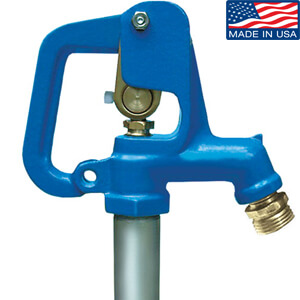
Design and Materials
Measuring four feet in length, the 4802LF requires proper installation such that the valve resides two feet underground, below the frost line, while the hose connection is positioned two feet above ground level. Demonstrating the hallmark of superior yard hydrants, both the head and handle are constructed from robust cast iron, ensuring exceptional durability to withstand the demanding demands of daily use.
While featuring a ¾-inch NPT female inlet that facilitates substantial water flow, it lacks the adjustable shutoff valve found in the Woodford Y34-4 model. Consequently, the Simmons 4802LF does not provide adjustable flow rates, functioning only in an on/off capacity. However, this minor drawback can be conveniently rectified by incorporating an in-line valve into your hose assembly.
For individuals residing in regions subject to freezing winter conditions, the concern of frozen pipes looms large. Nonetheless, this worry can be alleviated thanks to the remarkable bury depth and frost-proof design of the Simmons 4802LF, enabling unrestricted usage for washing, irrigation, or livestock watering throughout the year.
Overall Assessment
The Simmons 4802LF Premium Frost-Proof Yard Hydrant presents a plethora of admirable features. Yet, its most notable attribute, as the name implies, lies in its resilient frost-proof construction. Those dwelling in areas akin to the Arctic Circle or regions that experience severe winter climates would be well advised to consider the Simmons 4802LF as an astute choice for their yard hydrant needs.
- Well-made
- Frost-proof design
- Easy to install
- Affordably priced
- No adjustable water flow valve
- Cast iron head may crack if left exposed in sub-zero temps
3. Everbilt EBYH06NL – Best Budget-Friendly Yard Hydrant
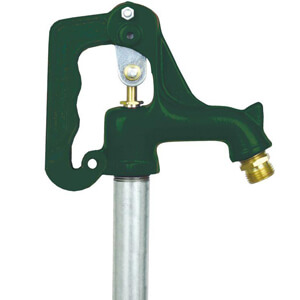
Design and Materials
This affordable Everbilt yard hydrant is made of heavy-duty, lead-free cast iron and features a brass rod and hose connector as well as a double O-ring seal to ensure a positive seal time and time again.
In addition to being cast iron, the head features a nifty bucket hook and the handle is oversized for ease of use. Meanwhile, the standpipe is made of one-inch galvanized steel, making it more than capable of standing the test of time.
As far as the plunger is concerned, it’s a one-piece, self-draining system that can easily be adjusted with the turn of a screw. This is a big plus, especially for a yard hydrant in its price range.
Speaking of big pluses, this Everbilt is also frost-proof. With a bury depth of six feet, its self-draining shut off valve operates beneath the frost line to reliably provide running water for irrigation on the coldest of winter days.
Overall
The Everbilt 6-Foot Yard Hydrant is one of the most affordably priced yard hydrants available, but its quality is just as impressive as its price. It has a rugged, frost-proof construction and a number of nifty design details to improve its operability and ease of use. If you want a great deal on a high-quality yard hydrant, it’s tough to go wrong with this Everbilt.
- Very well-priced
- Heavy-duty cast iron handle and head
- Oversized handle for easy operation
- Deep bury depth
- Adjustable self-draining shutoff valve
- Cast iron head may crack in freezing weather if not covered
- Up and down rod is made of brass but feels a little cheap
Yard Hydrant Made Easy Model 303 – Best Performing Yard Hydrant Replacement System
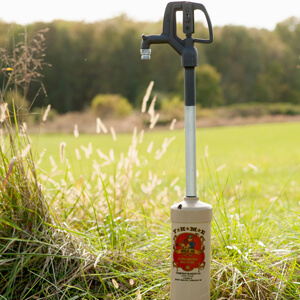
A Great Design
Without even considering the proprietary technology used in the YHME 303, this is still one of the more impressive yard hydrant systems that we encountered from a pure specs perspective. It is important to note that the YHME 303 does not include the hydrant head or pole which generally designates a “yard hydrant”. Still, this is one of the few yard hydrant systems we saw that came with a lead-free brass dual-check backflow valve to help protect the water in the hydrant from flowing back into the water supply. This feature is then reinforced with a waterproof, UV-protected PVC tubing and ABS top cap that is held in place with stainless steel hardware. Finally, the entire product provides a wide range of installation options with the inclusion of a telescopic design that can reach depths of anywhere from 3’ to 7’.
Thinking Ahead
How to Install a Yard Hydrant Made Easy
- Has a telescoping design
- Is much easier to replace
- Can accommodate depths between 3’ to 7’
- Has a lead-free brass pitless adapter
- Has a dual-check backflow
- Uses waterproof and water-resistant components
- Is the most expensive product reviewed
- Does not come with the base hydrant
Best Frost Proof Yard Hydrant – Buyer’s Guide
What is a Yard Hydrant?
Want a water source in your garden, barn, or out in a field? With a yard hydrant, you can tap into your well and access fresh groundwater virtually anywhere.
A yard hydrant is specialized plumbing hardware that connects to a buried well water supply pipe. Most have a shut-off valve, drain plug, and cast iron handle approximately two feet above the ground to make turning the water on and off a breeze.
What is a Yard Hydrant Used For?
Most property owners utilize yard hydrants to irrigate lawns or gardens, provide water for livestock, and wash their cars, trucks, or equipment. They can be installed to access water at various locations and used throughout the year for a constant source of water for irrigation, livestock, and more.
How Does a Yard Hydrant Work?

In keeping with this simple concept, yard hydrants basically work two ways:
- Open – A yard hydrant opens and allows water to begin flowing when the handle is lifted. This lifts the plunger and seals the drain hole, allowing water to flow.
- Closed – A yard hydrant closes when the handle is pushed down to close the plunger. Meanwhile, the drain hole is opened to drain water from the head and riser pipe to prevent freezing and cracking. With a frost-proof hydrant, the water is also stopped by the plunger below the frost line to make sure no freezing can occur.
What is a Shut-Off Valve?
Some call it a shut-off valve and others call it a stop-and-drain valve. Regardless of what it’s called, this important valve is a major component of any yard hydrant.
It’s located beneath the ground below frost level, usually at two to four feet underneath the ground surface. The valve is operated by a handle connected to the control rod.
When the handle and rod are lifted, the valve opens to allow water to flow from the main water pipe, up the riser pipe, and out through the hydrant’s head. When closed, the water flow stops and the valve’s drain hole opens to allow the water to drain from the riser pipe and into the gravel below to prevent ice formation.
Yard Hydrant Installation Tips
- Use plenty of gravel.
Proper drainage is a must, so it’s important to use a minimum of one cubic yard of coarse gravel as a drain bed around the hydrant’s shut-off valve.
- Use a one-inch water supply pipe.
The water pipe supplying water to the hydrant should always be at least an inch in diameter in order to ensure the proper supply and delivery of water.
- Make adjustments.
When installing yard hydrants, or just about anything else for that matter, making adjustments is par for the course. With a yard hydrant, you’ll need to check to make sure there is unrestricted water flow when the valve is opened, no drain hole leaks, and proper drainage when the valve is closed.
- Make adjustments prior to backfilling.
It may seem obvious, but it’s worth pointing out that you should test the hydrant and make any adjustments before you add in the backfill. By doing so, you’ll save yourself minutes of digging and possibly days of back pain.
How to Test for Proper Drainage
To test your hydrant and make sure it is draining properly, perform the following steps:
- Open the valve and allow the water to run.
- Close the valve and hold out your hand under the head spout.
That’s it. If you feel suction, the hydrant is draining as it should.
Where to Install a Yard Hydrant
Otherwise, you can install a yard hydrant anywhere on your property with access to the main well pipe.
Using a Yard Hydrant During the Summer and Winter Months
Yard hydrants are pretty simple and easy to operate. However, there are a few things to know before installing and using one.
For instance, if you plan on using it a lot during the summer months, you may want to install a globe valve or hose bib on the hydrant outlet. With one of these add-ons, you can leave the valve open during the summer months and keep the gravel bed dry for better winter drainage.
Conversely, if you live in a colder climate and use a yard hydrant during the winter months, it would be wise to occasionally draw off 25 gallons or so of water. Doing so will melt the ice naturally built-up within the riser pipe.
How to Unfreeze a Yard Hydrant
A yard hydrant can freeze for a number of reasons, such as a saturated drainage bed, faulty valve adjustment, or a plugged drain. It can also freeze from improper use, like an incomplete shut-off.
The Bottom Line
There are a lot of yard hydrants out there and they all basically do the same thing. However, some are easier to use and do it better than others.
If you’re reading this, chances are you’re new to yard hydrants and came here for some sound advice. Hopefully, we’ve answered your questions and helped you feel comfortable enough to pick the best yard hydrant for your property and needs.
Are frost and freezing temps a concern? Do you want a yard hydrant with an adjustable flow rate for a variety of uses? is budget a concern?
Your answers to these questions will help determine the right hydrant for you. So, consider your needs, review the three great options above, and pick one out to access fresh, clean groundwater today!
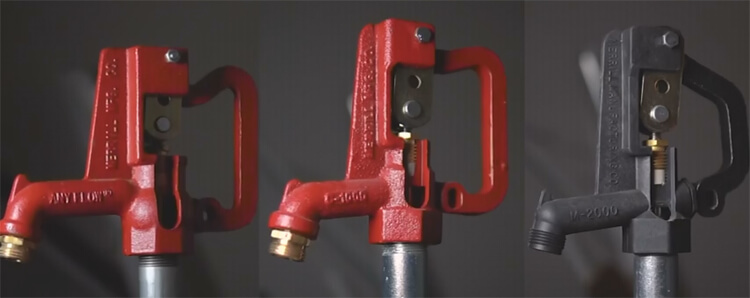

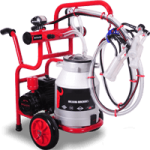
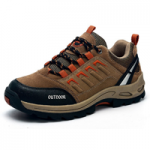
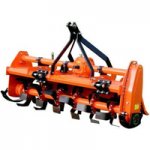
You have made a serious error. None on the hydrants listed are suitable for potable use. In particular the Yard Hydrant Made Easy. All the hydrants you listed are known as a cross contamination device whereby contaminated water will enter the supply line up stream to the house or well and exit the outlet of the hydrant making unsuitable for RV, campgrounds or drinking. In order to meet potable water requirements they must meet the ASSE 1057 sanitary yard hydrant standard.
Herb Hoeptner, the author has not made a “serious error.”
Yard hydrants in general are not considered a potable water source, except in some cases where the very expensive, canister-type “sanitary” hydrants are installed. This is well known. Even the “sanitary” hydrants have a major drawback in that the water in the canister does not drain out as it does in a normal yard hydrant. This stored water may stagnate for months, growing mold and bacteria, waiting for the next user.
I don’t believe the author has implied that any of the products reviewed change the water from non-potable to potable. He is simply reviewing products that have been available on the market for a long time in their normal context.
The Yard Hydrant Made Easy™ is no different in this regard. It is a casing system that offers many benefits to the hydrant owner, the primary being super quick and easy hydrant replacement. The YHME does not claim to magically turn a non-potable hydrant into a potable one. All of the product literature is clear on this. The Yard Hydrant Made Easy™ is SAFE to use anywhere you would use a standard 3/4″ yard hydrant. Whether or not the hydrant is considered potable is outside the purview of the YHME.
The Yard Hydrant Made Easy™ Model 303 comes with an ASSE 1024 stamped and approved dual-check-valve back-flow preventer to protect the water source from any back-siphonage. While this does protect the water source, Yard Hydrant Made Easy™ has never claimed to make the water exiting the hydrant potable.
It is not a matter of weather a weep hole style hydrant can make non potable water potable. The fact of the matter is that all weep hole hydrants can an eventually will make potable water non potable. Nationally, both ICC and UPC codes prohibit the use of weep hole hydrants without a testable backflow preventer up stream of the hydrant that must be tested annually, and the hydrant must be tagged NON POTABLE. Sanitary yard hydrants have no such requirements. (see ASSE 1057 Sanitary Yard Hydrant standard)